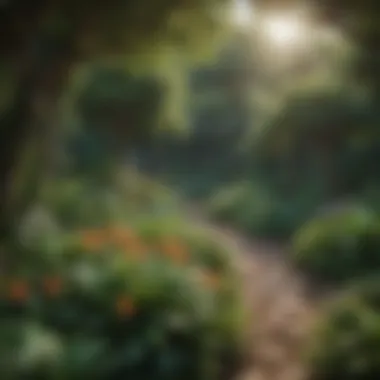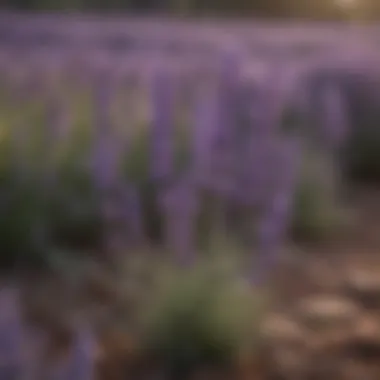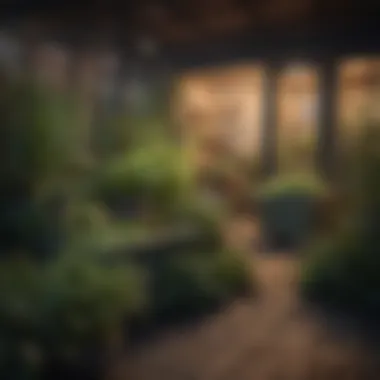Optimal Botanical Solutions for Mosquito Repulsion


Intro
In a world where the hum of mosquitoes can overshadow a serene evening outdoors, the quest for effective repellent solutions often leads us to the realm of nature itself. This journey explores the enchanting world of plants that not only keep mosquitoes at bay but also elevate the aesthetic quality of outdoor spaces. As we delve into the botanical properties of various species, we unveil how their cultivation can harmoniously blend utility with beauty.
Understanding these natural repellents is essential for anyone who wishes to create a comfortable outdoor environment, be it for a backyard gathering or a picturesque garden. This guide is tailored to luminous minds who value both form and function in their surroundings, ensuring every plant serves a dual purpose — enhancing the landscape while warding off pests. Whether you're an expert interior designer or a luxury event planner, the insights shared will empower you to curate enchanting outdoor experiences that resonate well with comfort and elegance.
"Nature’s solutions often lie within its own design, waiting for us to discover their true potential."
As we embark on this exploration, we will examine several plants renowned for their mosquito-repelling properties. We will analyze their botanical features, the best practices for cultivation, and how their mere presence can transform outdoor settings into fashionable retreats. Let’s take a closer look, shall we?
Understanding Mosquito Behavior
Understanding the behavior of mosquitoes is pivotal when seeking effective botanical solutions for their repulsion. By comprehending their habits, preferences, and life cycles, one can craft a more strategic approach to mitigate their presence. Recognizing what brings these pests buzzing can inform choices in plant selection and placement in gardens or outdoor spaces. The more enlightened the approach, the better equipped one is to create not only a comfortable atmosphere but also an attractive landscape that serves dual purposes.
The Life Cycle of Mosquitoes
Mosquitoes undergo a fascinating transformation throughout their lives, which can be divided into four main stages: egg, larva, pupa, and adult. Each stage demands specific environmental conditions. For instance, eggs are typically laid in or near water sources, like ponds or stagnant rainwater. During the larval stage, they thrive in warm, still water, feeding on microorganisms, before evolving into pupae. The adult mosquito eventually emerges and begins a quest for blood to facilitate reproduction.
Considering this life cycle provides a window of opportunity for botanical interventions. By selecting plants that can disrupt breeding grounds—such as those that naturally dry out water sources or provide natural predators for mosquito larvae—one can effectively reduce their population before it grows out of hand.
Attractants for Mosquitoes
Several attractants lure mosquitoes, and understanding these factors can change the game in pest control. Carbon dioxide emitted from people is a prime attractant, combined with body heat and certain body odors. Interestingly, floral scents and plant-based odors may also attract mosquitoes, particularly among female individuals seeking a meal.
Identifying such attractants allows for informed decisions in garden planning. For example, if a homeowner desires a fragrance-rich garden, it’s wise to position such plants away from areas where people gather, to lessen mosquito enticement.
- Common attractants include:
- Carbon dioxide
- Body heat
- Floral fragrances
The Importance of Repellents
Repellents are critical in thwarting the alluring pull that mosquitoes exert. Understanding how certain botanical varieties can act as natural repellents arms one with knowledge to enhance outdoor enjoyment. Not all plants are equal when it comes to repelling mosquitoes; the key is in the specific volatile compounds they emit. For example, citronella is widely recognized for its capacity to deter these pests.
However, it’s prudent to remember that relying solely on botanical solutions may not suffice. Instead, integrating plants with other repellents, such as essential oils or strategic landscaping practices, can amplify effectiveness against mosquitoes.
Evaluating Effective Plants
When it comes to creating a haven that’s both beautiful and functional, understanding the role of plants in repelling mosquitoes is pivotal. Evaluating effective plants means looking beyond just aesthetics. It's about prioritizing properties that maximize protection against these pesky pests while enhancing the ambiance of our spaces. As a collective approach becomes more essential in both ecological and comfort terms, exploring what makes a plant not just decorative but useful is a key step in curating a landscape that thrives.
A thorough evaluation encompasses various aspects—the botanical characteristics of the plants, their adaptability to different environments, and their overall cultural relevance. The ultimate goal is to select candidates that are effective repellents while also being harmonious within the broader ecosystem. This understanding becomes fundamental for professionals like luxury travel curators and fine dining consultants, as they strive to offer experiences that are both luxurious and practically enjoyable, free from the nuisance of mosquitoes.
Identifying Key Properties
To combat mosquitoes effectively, it’s crucial to pinpoint the attributes that make certain plants particularly potent. Plants often deploy their own natural mechanisms to ward off pests through aromatic oils or toxins that mosquitoes find repelling. Common characteristics to consider include:
- Essential Oil Content: Many plants, like citronella and lemongrass, contain oils that create a scent barrier mosquitoes dislike.
- Growth Habit: The way a plant grows—whether densely or sparsely—can influence its effectiveness in creating a protective screen against mosquitoes.
- Environmental Adaptability: How well a plant flourishes in varying weather conditions will determine its long-term viability in an outdoor setting.
Understanding these properties allows designers and planners to make informed decisions, mixing practicality with visual appeal, essential for cultivating areas that please the eye while safeguarding comfort.
Cultural Significance in Repelling Mosquitoes
Historically, various cultures have utilized plants for their mosquito-repelling properties. Some practices have persisted through generations, highlighting an intrinsic understanding of botanicals long before scientific explanations solidified these relationships.
For instance, in Southeast Asia, locals often employ lemongrass, which they not only value for its culinary applications but also for its effectiveness against mosquitoes. In Mediterranean cultures, lavender isn’t just a delightful scent; it has long been regarded for its ability to ward off insects, becoming a staple in gardens meant for relaxation and harmony.
By integrating plants with historical depth, one adds layers of meaning to landscapes. It's essentially storytelling through botany, where each plant can evoke past traditions and the cultural wisdom that enriches living spaces.
Selection Criteria for Plants
Choosing the right plants for mosquito control goes beyond surface attributes. There are several nuanced criteria to consider:
- Local Climate Compatibility: Always assess how well a plant will fit within your regional climate. Native plants, for example, often exhibit resilience.
- Maintenance Needs: Some plants flourish with minimal care, while others may require regular attention. Balancing aesthetic desires with practical upkeep is vital.
- Aesthetic Value: While functionality against mosquitoes is paramount, the visual appeal shouldn’t be overlooked. A well-designed garden integrates both function and form seamlessly.
- Companion Planting: Understanding how different plants work together can heighten effectiveness in repelling mosquitoes while enriching the ecosystem as a whole.
Top Plants for Mosquito Control
When it comes to keeping mosquitoes at bay, the selection of plants can play a pivotal role. Beyond just acting as barriers, these botanical solutions significantly enhance the aesthetic appeal of outdoor spaces, turning your garden into a stunning refuge. Using the right plants not only nurtures the environment but also contributes to a pleasant outdoor experience, free from those pesky biters.
The following sections will explore plants like Citronella Grass, Lavender, Basil, Neem, and Peppermint. Each of these makes a powerful ally in the battle against mosquitoes. They possess unique characteristics that not only repel mosquitoes but, at the same time, serve culinary, medicinal, or decorative purposes, which adds to their value in any garden setting.


Citronella Grass
Characteristics
Citronella grass is well known for its unmistakably strong, fresh scent. This characteristic is not just for show; it’s a key factor in its effectiveness against mosquitoes. The oils produced by this plant contain natural compounds that mask human scents, which can make it a very popular choice in mosquito repulsion strategies.
One unique feature of citronella grass is its tall stature, often reaching heights of up to five feet. This can add an interesting vertical element to your garden design. However, it’s important to know that while it works wonders, it can spread quite aggressively if not contained properly.
Growth Conditions
Citronella grass thrives in warm, sunny environments and well-draining soil. This makes it ideal for subtropical and tropical regions, as well as sunny garden spaces elsewhere. It’s a resilient plant that can tolerate some drought, which is a plus for those not wanting to babysit their garden every day.
However, in cooler climates, citronella grass may not survive the winter unless brought indoors or placed in protective conditions, so that's something to consider if you're in a less forgiving climate.
Usage Tips
For maximum effectiveness of citronella, it's recommended to crush the leaves to release the essential oils before using it in outdoor areas. This can be done by rubbing the leaves between your fingers or pricking them with a garden tool. This method enhances the scent and keeps mosquitoes away from the vicinity. As a bonus, it also brings a refreshing lemon aroma to your space, making your outdoor gatherings more inviting.
Lavender
Aromatic Qualities
Lavender's aromatic qualities serve as a feast for the senses, but it also does wonders to keep mosquitoes at bay. The plant's fragrant oils repel moths, fleas, and, of course, mosquitoes. The calming scent of lavender, coupled with its repellent properties, makes it a perfect addition to relaxing outdoor areas.
The unique feature of lavender is its ability to thrive in various conditions while still emanating a pleasant aroma. This allows homeowners to enjoy its benefits without overly complicated maintenance.
Medicinal Properties
Lavender isn't just a pretty face; it boasts a variety of medicinal properties. From aiding in stress relief to potentially helping with insomnia, its benefits extend far beyond the garden. Its calming properties can enhance the overall atmosphere of outdoor spaces, promoting relaxation and comfort.
However, be aware that while lavender has many benefits, it may not be suitable for all skin types. Some people may experience allergic reactions, so it's wise to test a small area first if using lavender in any topical application.
Landscape Applications
Lavender serves not just as a practical repellent but also adds color and texture to any landscape. Its violet blooms in summer create a rich visual experience, bringing life to your garden. It pairs beautifully with other plants like rosemary and sage, creating a harmonious aesthetic.
That said, lavender generally prefers drier conditions and may require regular trimming to maintain its shape and encourage new growth. Knowing this can be beneficial to keep it looking its best.
Basil
Culinary Uses
Basil is more than just a culinary delight; it also acts as a natural mosquito repellent. Known for its vibrant green leaves and aromatic qualities, it’s a staple in many kitchens around the world. Fresh basil adds a kick to salads, sauces, and cocktails, making it both functional and versatile.
One unique aspect of basil is its ability to blend seamlessly between culinary uses and pest-repellent properties, adding value when utilized in a garden.
Repellent Factors
The compounds in basil, particularly eugenol, are known to deter mosquitoes. When crushed, the scent becomes even more potent, providing an added layer of protection. This makes basil not only a flavorful addition to dishes but also a smart choice for keeping pests at bay.
However, it's worth mentioning that while basil is effective, it's not entirely foolproof. For maximum effectiveness, it should be planted in clusters to create a stronger scent.
Growing Conditions
Basil requires warm conditions, plenty of sunlight, and well-draining soil. It’s quite adaptable and grows well in pots, making it a charming option for balconies and patios. Alternatively, basil is also a great edible plant to grow in vegetable gardens.
Keep in mind that basil does dislike cold weather, so it’s best planted after the last frost is gone. This is crucial to ensure a hearty growth.
Neem
Traditional Uses
Neem has a long history of use in traditional medicine and pest control. Known as the "heal-all" tree in many cultures, neem’s leaves, bark, and oil have been used in everything from skincare to organic pest repellent formulations.
This depth of knowledge surrounding neem's applications adds significant value, making it a must-consider plant for gardens looking to balance utility and aesthetics.
Environmental Benefits
Neem is an environmentally friendly choice for pest control. It’s non-toxic to most beneficial insects, which allows you to maintain a naturally balanced ecosystem in your garden. This unique feature means that while neem will deter mosquitoes, it will not harm bees or ladybugs that pollinate your other plants.


Despite its benefits, it's crucial to use neem responsibly. Over-application can lead to imbalances in your local ecosystem.
Cultivation Practices
Growing neem is relatively straightforward, as this resilient tree can tolerate poor soil conditions and drought. Given the right space, it can thrive and grow tall quickly. This aspect makes it a valued addition for those with room to spare in their gardens.
However, on the downside, neem may not be practical for those with limited space, as its size can be challenging in smaller landscapes.
Peppermint
Flavor Profile
Peppermint is cherished not only for its intense flavor but also for its ability to repel mosquitoes effectively. Commonly used in teas, desserts, and even savory dishes, its robust taste can refresh any meal.
This versatility in culinary uses makes peppermint a desirable choice for kitchens and gardens alike.
Growing Requirements
Peppermint prefers damp soil and partial shade, which can be ideal for those with less sunny garden spots or areas where other plants may struggle. It can quickly establish itself, so controlling its spread may be necessary if you want to maintain a tidy garden.
Its fast growth can be both an advantage and a disadvantage; it’s beneficial for quick ground cover but might crowd out other plants without proper management.
Application Techniques
Using peppermint for mosquito control can be as simple as placing fresh leaves around sitting areas or utilizing the essential oil in diffusers. The aroma is generally refreshing, which makes it a delightful addition to any outdoor gathering.
In essence, peppermint can serve dual roles well, though it's important to remember that like with all plants, individual experiences can vary based on environmental factors.
Cultivating a Mosquito-Repellent Garden
Creating a garden that not only pleases the eye but also wards off pesky mosquitoes is essential for many seeking an outdoor haven. Understanding how to cultivate a mosquito-repellent garden is not just about aesthetics; it's about creating an environment that minimizes discomfort and enhances outdoor enjoyment. The combination of strategically chosen plants, proper techniques, and thoughtful maintenance can transform any backyard into a serene retreat.
Soil Preparation Techniques
Good soil is the foundation of a thriving garden. But it’s not just about making the ground nice and fluffy. It’s about ensuring that the soil is fertile enough to support the growth of mosquito-repellent plants like citronella grass or lavender. Before planting, you should assess the soil quality. Start by testing the pH level, as most plants prefer a slightly acidic to neutral pH. Incorporate organic matter like compost or well-rotted manure to improve both drainage and nutrient availability. A well-prepared soil mix can boost plant health significantly, which, in turn, helps in maximizing their repellent qualities.
Key soil preparation tips:
- Test soil pH: Aim for a pH between 6.0 and 7.0 for optimal plant health.
- Add organic matter: Compost enriches the soil, making it ready for planting.
- Ensure proper drainage: Mosquito-repellent plants won't thrive in soggy soil.
Planting Strategies
When it comes to planting, consider not just how the plants look next to each other but also how they work together to fight off mosquitoes. Group similar plants together to create a concentrated area of aromas, as many mosquitoes are deterred by strong scents from essential oils present in some plants. It's also smart to plant these in locations where you enjoy spending time, such as near seating areas or patios.
Selecting the right time to plant is crucial. Early spring or fall often provides optimal growing conditions. When planting, ensure that spacing between each plant allows for good airflow, minimizing moisture build-up, which mosquitoes love. Also, follow recommended planting depths; too shallow or too deep can hinder each plant's growth and efficacy.
Maintenance and Care
Once your mosquito-repellent garden is established, ongoing care becomes paramount. Regular maintenance not only keeps the plants healthy but also enhances their ability to repel mosquitoes. This includes watering, pruning, and pest management.
In dry spells, ensure consistent watering, but avoid waterlogging. Mulching can help retain moisture and suppress weeds, which compete for nutrients. Pruning is another critical aspect. Regularly trimming back overgrown plants not only promotes healthy growth but also boosts their aromatic oils, heightening their repellent properties.
Additionally, keep an eye out for pests that can compromise plant health. Effective pest management techniques can include attracting beneficial insects or using natural pesticides, as chemical options might deter the desired flora or even the natural predators.
“A well-kept garden is a reflection of the health it represents – both visually appealing and functionally effective.”
In sum, cultivating a mosquito-repellent garden is a multifaceted endeavor that blends science with art. By preparing the soil, planting thoughtfully, and maintaining diligently, one can craft an outdoor space that not only repels mosquitoes but also serves as an exquisite backdrop for luxurious living.
Complementary Practices for Mosquito Control
In the pursuit of keeping mosquitoes at bay, it's paramount to view botanical solutions as just one piece of the puzzle. Complementary practices can significantly enhance the efficacy of plant-based repellents. Integrating these strategies not only strengthens your defense against mosquitoes but also promotes a healthier environment. Whether you are hosting an outdoor soiree or simply enjoying your garden, being proactive in mosquito management helps create an inviting atmosphere free from the buzz that disrupts tranquility.
Water Management
This phase cannot be overstated. Mosquitoes thrive in stagnant waters, making water management a key aspect of repulsion strategies. By ensuring proper drainage around your property, you can effectively deny mosquitoes a breeding ground.
Here are some specific techniques:
- Regularly Empty Containers: Flower pots, bird baths, and children's toys can collect water. Make it a routine task to empty any standing water every few days.
- Elegant Water Features: Instead of still water bodies, consider installing moving water features like fountains. The sound of trickling water is not just a charming addition—but it also discourages mosquitoes from congregating.
- Drainage Solutions: If natural channels are disrupted and uses in your environment, it might be a wise decision to consult a landscaping professional for drainage enhancement to prevent pooling.


Natural Predators
Every ecosystem has its balance, and introducing natural predators can be an ingenious approach to manage mosquito populations. Certain creatures feast on mosquito larvae and adults, keeping their numbers in check without relying solely on chemicals or repellents.
Consider these natural allies:
- Bats: These winged mammals munch on hundreds of insects in a single night. Installing bat houses can attract them to your surroundings, providing an organic balance.
- Dragonflies: Known as mosquito hawks, dragonflies prey on mosquito adults. Planting particular flowers can draw these helpful insects to your garden.
- Fish: Koi and goldfish can reduce larvae in pond waters. Just be mindful of their care needs and the aesthetic integration within your landscape design.
Seasonal Considerations
Understanding the seasons is crucial when managing mosquitoes. Different seasons bring varying behaviors and populations of mosquitoes. Adjusting your strategies accordingly can prove beneficial.
- Spring Preparation: This is the time they emerge. Start your prevention methods early by preparing your garden with mosquito-repelling plants.
- Summer Vigilance: During peak mosquito activity, ensure regular maintenance of your landscape. Properly prune and care for plants while applying additional repellent methods.
- Fall Cleanup: As plants die back, potential breeding sites can emerge from debris. Clean gutters and clear leaf piles to minimize attractants for overwintering mosquitoes.
- Winter Defense: While many mosquitoes hibernate, being proactive now can pay off later. Invest in design elements and prevent water stagnation during the thaw.
"A holistic approach that intertwines plant solutions with habitat management is not just prudent—it's a demonstration of thoughtful outdoor living."
The Role of Aesthetics in Outdoor Spaces
Aesthetics play a pivotal role in landscaping, especially when integrating plants that serve a dual purpose of beautifying an area while repelling annoying mosquitoes. The visual appeal of a garden or outdoor space attracts visitors, creates a welcoming atmosphere, and can even elevate the standing of a property. When planning a mosquito-repelling landscape, it’s essential to approach it not just from a functional perspective but also from an aesthetic one. Choosing the right plants can lead to a harmonious blend of practicality and beauty, enhancing the overall experience of those who enjoy the space.
Integrating Plants into Landscape Design
When selecting plants for your garden, think about how they fit within the overall design. Mosquito-repelling plants such as citronella grass, lavender, and basil have distinct shapes and colors that can lend visual intrigue to your outdoor space.
- Layering: Arrange plants in layers, varying heights from taller varieties in the back to shorter ones in front. This provides depth and interest.
- Symmetry: Use symmetry for pathways or central features like fountains, pairing plants of similar sizes and colors on either side.
- Theme: Consider a unifying theme. Whether it’s a Mediterranean vibe with rosemary and thyme or a lush tropical feel with peppermint and lemongrass, the plants chosen should reflect an overall cohesive aesthetic.
The combination of visual complexity with practical mosquito deterrence can be a win-win.
Color and Texture Combinations
An eye-catching garden relies heavily on color and texture. The brilliance of flowers against the backdrop of lush greens creates a stunning visual feast. When selecting mosquito-repellent plants, aim for a mix that offers both vibrant colors and varied textures:
- Color Palette: Consider how colors complement one another. For instance, the soothing purple hue of lavender pairs exquisitely with the rich green of basil.
- Textural Diversity: Combine smooth, glossy leaves with those that have a rougher texture to enhance tactile variety. Peppermint's bright green, crinkled leaves can contrast nicely with the sleek blades of citronella grass.
Incorporating such combinations not only enhances aesthetics but can also create a more inviting space for outdoor relaxation.
Creating a Harmonious Environment
Creating a harmonious outdoor environment goes beyond mere aesthetics. It fosters a sense of well-being, encourages outdoor engagement, and promotes social interaction. Incorporating mosquito-repelling plants can achieve that balance while ensuring comfort.
- Cohesiveness: Ensure that the design elements, including pathways, seating areas, and plants, reinforce each other and create a seamless flow through the space.
- Comfort Zones: Designate areas where one can retreat or gather. Use mosquito-repellent plants around seating arrangements to keep pests at bay while ensuring an inviting and pleasant environment.
"The essence of a well-designed garden lies not just in its plants, but in its ability to provide peace and comfort amidst nature’s beauty."
By recognizing the benefits of aesthetics in outdoor spaces, particularly when dealing with mosquito management, you can craft an environment that is not only pleasant in appearance but also practical in purpose.
Long-term Strategy for Mosquito Management
Creating an effective long-term strategy for managing mosquitoes entails a multifaceted approach that integrates botany, ecology, and community engagement. It’s not just about planting a few mosquito-repelling plants and calling it a day. To truly keep these nuisances at bay, understanding their behavior, breeding habits, and environmental influences over time is crucial. The right plants coupled with sustained effort can lead to a noticeable reduction in mosquito populations, contributing to a more enjoyable outdoor experience.
Continuous Monitoring Techniques
Effective mosquito management demands a solid framework for continuous monitoring. This involves not only planting the right species but also keeping an eye on their development and maintenance phases. A routine check on the growth and health of the selected plants can help in gauging their effectiveness in repelling these pests.
- Set a schedule for regular observation of both plant health and the mosquito situation in your area.
- Use traps or natural indicators to assess mosquito activity throughout the seasons, noting peak times when populations surge.
- Engage local community members or professionals who specialize in pest management to share insights and findings.
By being vigilant and adapting to conditions as they change, you can proactively manage any upsurge in mosquito populations that might arise due to environmental factors.
Community Approaches
Battling mosquitoes effectively involves rallying the community. When neighborhoods unite, the efforts toward mosquito control become exponentially more potent. Through communal gardening initiatives, individuals can share their knowledge about which plants have shown the best results in repelling these pests.
- Initiate community events where people can learn about planting and maintaining mosquito-repellent greenery.
- Establish a neighborhood watch system focused on reporting stagnant water or breeding grounds.
- Sharing resources such as community compost or mulch can enhance growth conditions for these botanical defenses.
Collaboration also fosters a sense of responsibility among community members, reinforcing environmental stewardship.
Adapting to Climate Changes
As the weather pattern evolves, so does the behavior of mosquitoes. A long-term strategy must take this into account. Different plants and their repellent qualities might be effective now but can falter as climatic conditions shift. Understanding and adapting to these changes is critical.
- Research regional climate variations and their potential impacts on mosquito breeding and behavior.
- Stay informed about which plants are becoming more resilient to changing weather, and consider diversifying your selections to include adaptive species.
- Implement water drainage improvements and sheltered areas for plant growth that can withstand extreme weather.
By incorporating strategies that not only address the current conditions but also future challenges, individuals can build a resilient defense against mosquitoes that emphasizes long-term solutions rather than short-term fixes.
In summary, a successful mosquito management plan incorporates ongoing monitoring, community involvement, and adaptability to environmental changes, ensuring that outdoor spaces remain pleasant and mosquito-free.
With careful attention to these aspects, not only is your immediate environment enhanced, but a broader legacy of comfort and aesthetics is woven into the fabric of community living.







